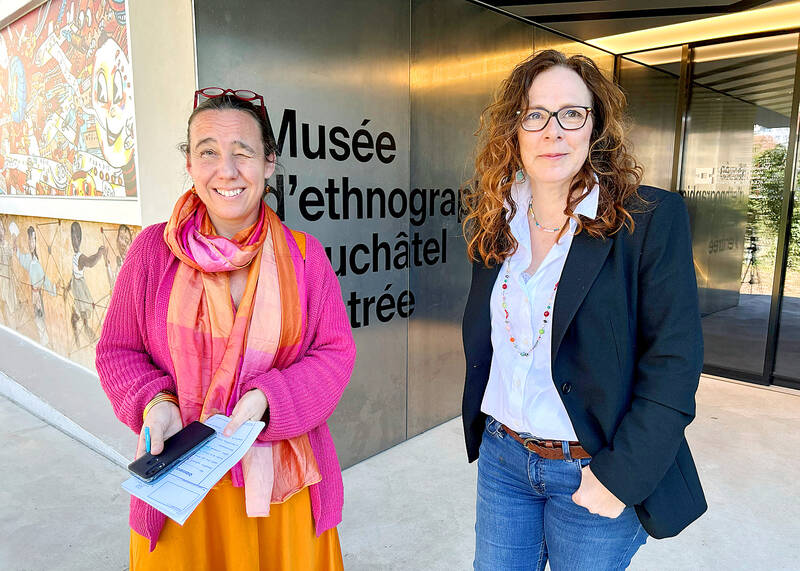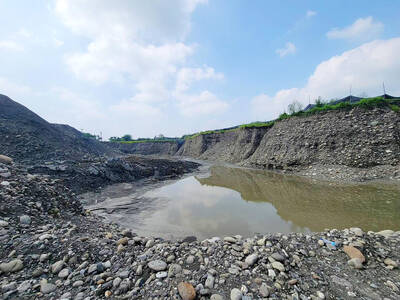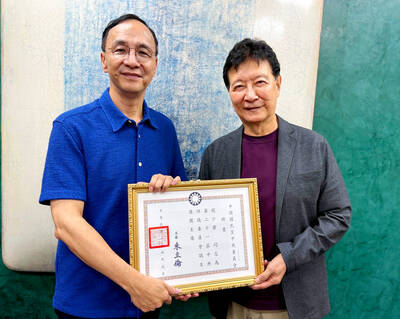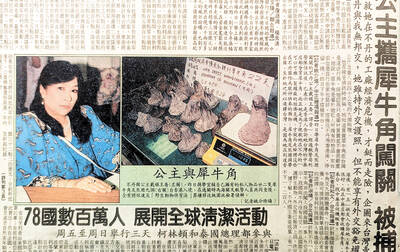The world’s woes got you down? Feeling burnout at work? Need a little something extra to fight illness or prep for surgery? The Swiss town of Neuchatel is offering its residents a novel medical option: Expose yourself to art and get a doctor’s note to do it for free.
Under a new two-year pilot project, local and regional authorities are covering the costs of “museum prescriptions” issued by doctors who believe their patients could benefit from visits to any of the town’s four museums as part of their treatment.
The project is based on a 2019 World Health Organization report that found the arts can boost mental health, reduce the impact of trauma and lower the risk of cognitive decline, frailty and “premature mortality,” among other upsides.

Photo: AP
Art can help relax the mind — as a sort of preventative medicine — and visits to museums require getting up and out of the house with physical activity like walking and standing for long periods.
Neuchatel council member Julie Courcier Delafontaine said the COVID crisis also played a role in the program’s genesis. “With the closure of cultural sites (during coronavirus lockdowns), people realized just how much we need them to feel better.”
She said so far some 500 prescriptions have been distributed to doctors around town and the program costs “very little.” Ten thousand Swiss francs (about US$11,300) have been budgeted for it.
If successful, local officials could expand the program to other artistic activities like theater or dance, Courcier Delafontaine said. The Swiss national health care system doesn’t cover “culture as a means of therapy,” but she hopes it might one day, if the results are positive enough.
Marianne de Reynier Nevsky, the cultural mediation manager in the town of 46,000 who helped devise the program, said it built on a similar idea rolled out at the Fine Arts Museum in Montreal, Canada, in 2019.
She said many types of patients could benefit.
“It could be a person with depression, a person who has trouble walking, a person with a chronic illness,” she said near a display of a feather headdress from Papua New Guinea at the Ethnographic Museum of Neuchatel, a converted former villa that overlooks Late Neuchatel.
Part of the idea is to get recalcitrant patients out of the house and walking more.
Dr. Marc-Olivier Sauvain, head of surgery at the Neuchatel Hospital Network, said he had already prescribed museum visits to two patients to help them get in better shape before a planned operation.
He said a wider rollout is planned once a control group is set up. For his practice, the focus will be on patients who admit that they’ve lost the habit of going out. He wants them to get moving.
“It’s wishful thinking to think that telling them to go walk or go for a stroll to improve their fitness level before surgery” will work, Sauvain said on a video call Saturday, wearing blue scrubs. “I think that these patients will fully benefit from museum prescriptions. We’ll give them a chance to get physical and intellectual exercise.”
“And as a doctor, it’s really nice to prescribe museum visits rather than medicines or tests that patients don’t enjoy,” he added. “To tell them ’It’s a medical order that instructs you to go visit one of our nice city museums.’”
Some museum-goers see the upsides too.
“I think it’s a great idea,” said Carla Fragniere Filliger, a poet and retired teacher, during a visit to the ethnography museum. “There should be prescriptions for all the museums in the world!”

The depressing numbers continue to pile up, like casualty lists after a lost battle. This week, after the government announced the 19th straight month of population decline, the Ministry of the Interior said that Taiwan is expected to lose 6.67 million workers in two waves of retirement over the next 15 years. According to the Ministry of Labor (MOL), Taiwan has a workforce of 11.6 million (as of July). The over-15 population was 20.244 million last year. EARLY RETIREMENT Early retirement is going to make these waves a tsunami. According to the Directorate General of Budget Accounting and Statistics (DGBAS), the

Last week the story of the giant illegal crater dug in Kaohsiung’s Meinong District (美濃) emerged into the public consciousness. The site was used for sand and gravel extraction, and then filled with construction waste. Locals referred to it sardonically as the “Meinong Grand Canyon,” according to media reports, because it was 2 hectares in length and 10 meters deep. The land involved included both state-owned and local farm land. Local media said that the site had generated NT$300 million in profits, against fines of a few million and the loss of some excavators. OFFICIAL CORRUPTION? The site had been seized

Next week, candidates will officially register to run for chair of the Chinese Nationalist Party (KMT). By the end of Friday, we will know who has registered for the Oct. 18 election. The number of declared candidates has been fluctuating daily. Some candidates registering may be disqualified, so the final list may be in flux for weeks. The list of likely candidates ranges from deep blue to deeper blue to deepest blue, bordering on red (pro-Chinese Communist Party, CCP). Unless current Chairman Eric Chu (朱立倫) can be convinced to run for re-election, the party looks likely to shift towards more hardline

Sept. 15 to Sept. 21 A Bhutanese princess caught at Taoyuan Airport with 22 rhino horns — worth about NT$31 million today — might have been just another curious front-page story. But the Sept. 17, 1993 incident came at a sensitive moment. Taiwan, dubbed “Die-wan” by the British conservationist group Environmental Investigation Agency (EIA), was under international fire for being a major hub for rhino horn. Just 10 days earlier, US secretary of the interior Bruce Babbitt had recommended sanctions against Taiwan for its “failure to end its participation in rhinoceros horn trade.” Even though Taiwan had restricted imports since 1985 and enacted